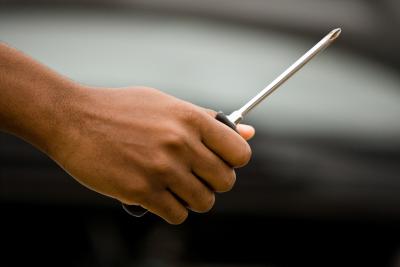
The panel speakers that come installed in the Subaru Forester are not sufficient to interpret the lowest tones in music. So if you desire a full-sounding stereo, you will need to add a subwoofer. Even aftermarket speakers provide less than stellar bass response when the goal is to create a truly well-rounded stereo system. You can add a powered subwoofer, which eliminates the need to install an aftermarket amplifier.
Remove the negative battery cable from the Subaru battery with a Phillips-head screwdriver.
Connect the ring terminal from the amplifier wiring kit to the positive lead of the battery.
Drill a hole in the firewall from the engine compartment to the inner cabin of the vehicle. An ideal location would be directly behind the battery. Put a rubber grommet in the new opening.
Feed the power supply cable attached to the ring terminal through the firewall to the inside of the vehicle.
Remove the trim panels that hold the carpeting to the floor of the Forester with a trim panel remover. Lay the power supply cable beneath the carpet, near the doors of the vehicle, to the rear cargo area of the Subaru. Replace the trim panel by hand. The panel will snap back into place with even pressure along the panel.
Reach under the rear lip of the gear selector lever compartment. You can feel an edge through the shifters bag. Pull upward to remove the center console panel.
Pull the trim panel surrounding the stereo at the bottom and work your hands around the perimeter until the panel is removed from the dash. Disconnect the wiring to the climate control knobs by pulling them from the back of the panel.
Remove the four screws at the corners of the stereo mounting bracket with a Phillips-head screwdriver. Pull the stereo from the dock far enough to reach the wiring connected to the rear of the radio.
Pull the wiring from the rear of the stereo. There will be single cables for the antenna and the power supply. The speaker wires will be connected in a bundle grouped by a plastic wire binder. Pull the speaker wires by the binder, not the wires themselves.
Connect the wiring from the vehicle to a wiring harness adapter. Connect the adapter leads to the stereo. This will provide a standard platform for connecting components to the stereo.
Connect the signal cable and turn-on lead from the amplifier wiring kit to the wiring harness adapter. Feed the amp wiring kit cables through the back of the stereo dock and down to the floor of the passenger side foot-well.
Replace the stereo in the mounting bracket. Replace the four perimeter screws with the screwdriver. Reconnect the climate control knob wiring to the back of the panel. Replace the trim panel by hand; it snaps in place with pressure around the edges.
Replace the center console panel. Align the forward edge of the panel against the bottom of the trim panel that surrounds the stereo. Push the panel into place with even pressure on both sides, from the front to the rear of the panel. It will snap into place.
Route the signal cable and turn-on lead to the rear cargo area of the vehicle. Lay the cables beneath the carpeting on the passenger side of the Forester. Use the trim panel tool on the panels on the right side of the vehicle to lift the carpeting. Replace the panels, securing the carpet, once the cables are laid.
Place the powered subwoofer in the rear cargo area of the Forester, behind the rear seats. Connect the signal cable, turn-on lead and power supply cable to the sub.
Connect the grounding wire (amp wiring kit) from the subwoofer to any bolt in the rear cargo area directly connected to the frame of the Forester. You may have to lift the carpeting in the rear cargo area to find a suitable bolt for grounding.
Place the negative battery cable clamp around the negative battery lead. Tighten the clamp with a Phillips-head screwdriver.